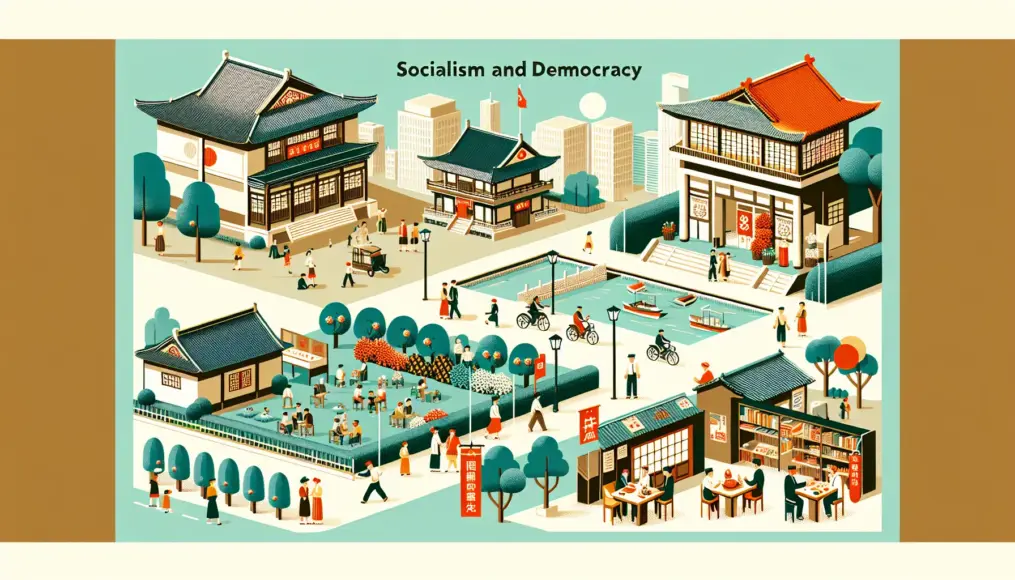Administrative reform is a crucial topic that significantly influences our society and daily lives. Understanding how changes in government structure and policies affect our lives, as well as the intentions behind these changes, is essential. In this article, we’ll delve into the specific definitions and objectives of administrative reform, reflecting on past examples to uncover its profound impact.
As reform progresses, it’s important to consider the changes that citizens may experience and the implications for the economy. We’ll also explore the factors that contribute to successful reforms and the challenges they face, all while connecting these developments to historical contexts and political movements.
So why not take this opportunity to explore the changes brought about by administrative reform together?
- An explanation of the definitions and objectives of administrative reform
- An examination of its impact on society and the economy
- Insights into the success factors and challenges of reform
What is Administrative Reform?
Administrative reform refers to a series of initiatives aimed at reviewing and improving the operations of government and local authorities, with a focus on enhancing efficiency and transparency. The ultimate goal is to provide better services to citizens and build a trustworthy government. Over time, administrative reform has evolved in response to various social needs and historical contexts. By understanding its content and impact, we can see how citizens benefit from these changes.
In this section, we will first delve into the definitions and objectives of administrative reform, followed by a look back at past reform initiatives. This will help us grasp how reforms have been implemented and what results they have yielded.
Definition and Objectives of Reform
Administrative reform is a crucial means for governments to function effectively and efficiently. Specifically, it aims to eliminate waste and improve the quality of services, ensuring that taxpayer money is used wisely. Additionally, to gain the trust of citizens, transparency and accountability are essential components of these reforms.
The objectives of reform extend beyond mere cost-cutting; they also focus on enhancing the quality of public services. This ensures that citizens receive the services they need more quickly and appropriately. Administrative reform is an ongoing process that continuously adapts to the changing times.
- The aim of administrative reform is to enhance efficiency and transparency
- Improving services for citizens is also a key goal
- Reform is an evolving process that adapts to the times
Examples of Past Reforms
Throughout history, various administrative reforms have taken place. For instance, Japan’s “Administrative and Financial Reform” of the 1990s aimed to eliminate waste in government operations while strengthening the authority of local governments. This reform enabled local authorities to operate more independently, allowing them to provide services tailored to the needs of their communities.
In recent years, the push for digitalization has led to the online streamlining of administrative procedures and better data utilization. This has simplified and accelerated processes, resulting in more user-friendly government services for citizens. These examples illustrate that administrative reform is a dynamic process that continues to evolve in response to societal needs.
- Administrative and Financial Reform promoted the independence of local governments
- Digitalization is simplifying administrative procedures
- Ongoing reforms are in progress to meet societal needs
The Impact of Administrative Reform on Society
Administrative reform is not just about increasing government efficiency; it profoundly influences our lives and the economy. Understanding how these reforms change society is crucial. In this section, we will delve into the effects of administrative reform on the economy and the changes in citizens’ daily lives.
The transformations brought about by reform can sometimes have unexpected consequences. While contributing to economic stability and growth, these changes can also introduce new conveniences and challenges into the daily lives of citizens. Let’s explore the specific impacts in more detail.
Economic Impact
Administrative reform plays a vital role in the economy as a whole. By streamlining government operations, unnecessary expenditures are reduced, and resources are allocated more effectively. This leads to improved quality of public services and strengthens the foundation that supports business activities.
Moreover, administrative reform can foster new business models and innovations. With the advancement of digitalization, companies can navigate administrative processes more swiftly, creating a more conducive business environment that fuels economic growth.
- Reduced unnecessary expenditures through government efficiency
- Enhanced quality of public services energizing business activities
- Improved business environment thanks to digitalization
Changes in Citizens’ Lives
Administrative reform also brings various changes to citizens’ lives. For instance, the simplification of procedures and the expansion of online services are expected to significantly reduce time and effort. As a result, citizens can enjoy a more convenient and comfortable lifestyle.
On the other hand, the introduction of new systems and rules can make adaptation challenging for some citizens. This is particularly true for the elderly and those who are not tech-savvy, as it may take them time to adjust to the new administrative services.
- Reduced burden on citizens through simplified procedures
- Enhanced convenience with the expansion of online services
- Challenges in adapting to new rules
Key Factors and Challenges in Administrative Reform
To achieve successful administrative reform, several critical factors come into play. It’s equally essential to understand the challenges that arise throughout the reform process. In this section, we will delve into the key factors for success and the challenges that need to be addressed in future efforts.
For reform to be effective, a clear policy vision and open dialogue with citizens are vital. Additionally, it’s crucial to incorporate the perspectives of stakeholders during implementation and to remain flexible in response to feedback. Let’s explore the specific success factors and challenges in more detail.
Factors for Success
There are numerous factors that contribute to successful administrative reform, but one of the most important is setting clear goals. By defining the objectives of the reform, stakeholders can develop a shared understanding, making collaboration easier. It’s also essential to incorporate citizen input, as building trust through a transparent process enhances engagement.
Moreover, strong leadership is indispensable for executing reform. Effective leaders drive the reform agenda forward and inspire stakeholders to participate actively. The combination of these factors paves the way for success.
- Importance of clear goal-setting
- Transparency in incorporating citizen input
- Strong leadership to drive reform
Challenges to Address
On the other hand, several challenges exist in the realm of administrative reform. One significant hurdle is the resistance to change. For individuals accustomed to traditional systems and practices, adapting to new rules and structures can be daunting. Therefore, education and information dissemination become crucial during the implementation phase.
Another major challenge is advancing reform within limited resources. Particularly in situations where budgets and personnel are scarce, progress can be sluggish. Overcoming these challenges requires sustained effort and a strategic approach.
To deepen your understanding of administrative reform, exploring related historical case studies can be incredibly beneficial. For instance, to complement your knowledge about the impacts of reform, check out the article “What Impact Did Postal Privatization Have on Japanese Society?.” This piece provides a detailed analysis of the background of postal privatization and the changes it brought to Japanese society.
- Overcoming resistance to reform
- Implementation with limited resources
- Need for continuous effort and a strategic approach
Historical Context and Political Dynamics
Behind administrative reform lies a significant interplay of historical context and political movements. Past reforms have evolved in response to societal changes and the needs of the public. By reflecting on history, we can understand how today’s administrative reforms fit within a broader narrative and how they have developed over time.
In this section, we’ll explore the historical backdrop of administrative reform and examine how it has been shaped by political influence. By looking at specific examples, we can see how the progress of these reforms has impacted society.
Historical Background of Reform
Administrative reform has emerged from various historical contexts. Particularly in post-war Japan, the need for economic recovery and enhanced international competitiveness made the streamlining of administration urgent. As a result, the 1950s and 60s saw significant efforts toward reforming government finances and re-evaluating the bureaucratic system.
As we moved into the 1990s, the economic downturn following the burst of the bubble necessitated another review of administrative practices. During this period, movements to strengthen the powers of local governments and promote privatization gained momentum. Historically, administrative reforms have clearly been influenced by economic conditions and public expectations.
- Demand for efficiency during post-war recovery
- Economic stagnation in the 1990s spurred reforms
- Movements to empower local governments and encourage privatization
Political Influences
Administrative reform is closely intertwined with political dynamics. The policies and strategies of politicians and political parties significantly impact these reforms, meaning that changes in administration or policy can affect the pace of reform. Particularly after elections, new reforms are often proposed, with the political landscape shaping the speed of these changes.
Moreover, political pressure and the voices of citizens are crucial elements driving reform. When citizens advocate for change, it prompts politicians to respond to those demands. Thus, administrative reform continually evolves in interaction with the political environment.
If you find this topic intriguing, you might also enjoy the article “A Deep Dive into the LDP’s Constitutional Draft: Its Impact on Modern Japan.” This blog discusses the historical context of the constitutional draft and its potential implications on contemporary Japanese politics. Like administrative reform, it’s a subject deeply influenced by political movements, so be sure to check it out!
- Policies of politicians and parties influence reform
- Election outcomes can spur new reforms
- Citizen voices play a crucial role in shaping politics
Conclusion
Administrative reform is a vital process aimed at enhancing the efficiency of government and local authorities, ultimately providing better services to citizens. As evident from its historical context and political developments, reform has consistently evolved in response to societal changes. Understanding the factors that contribute to success, as well as the challenges that need to be addressed, will play a crucial role in shaping the future direction of these reforms, especially considering their impact on the economy and citizens’ everyday lives.
Moving forward, it is essential for administrative reforms to reflect the voices of the community and build trust through transparent processes. Additionally, we must strive for a sustainable society by maximizing the use of limited resources. It is important to think about how administrative reforms will reshape our lives and how we can actively engage in this process.
- Administrative reform is key to providing better services to citizens.
- Reforms have evolved under the influence of history and politics.
- Efforts are needed to reflect citizens’ voices and aim for a sustainable society.
We would love to hear your thoughts and opinions on how administrative reform may impact our future.



Comment